Financial Decision Making: Importance of Accounting and Finance in SKANSKA plc
VerifiedAdded on 2023/06/18
|14
|3706
|347
AI Summary
This report evaluates the importance of Accounting and Finance in SKANSKA plc along with their roles and functions. It also includes the calculation of accounting ratios for Skanska plc and performance evaluation based on ratios.
Contribute Materials
Your contribution can guide someone’s learning journey. Share your
documents today.

Financial Decision
Making
Making
Secure Best Marks with AI Grader
Need help grading? Try our AI Grader for instant feedback on your assignments.

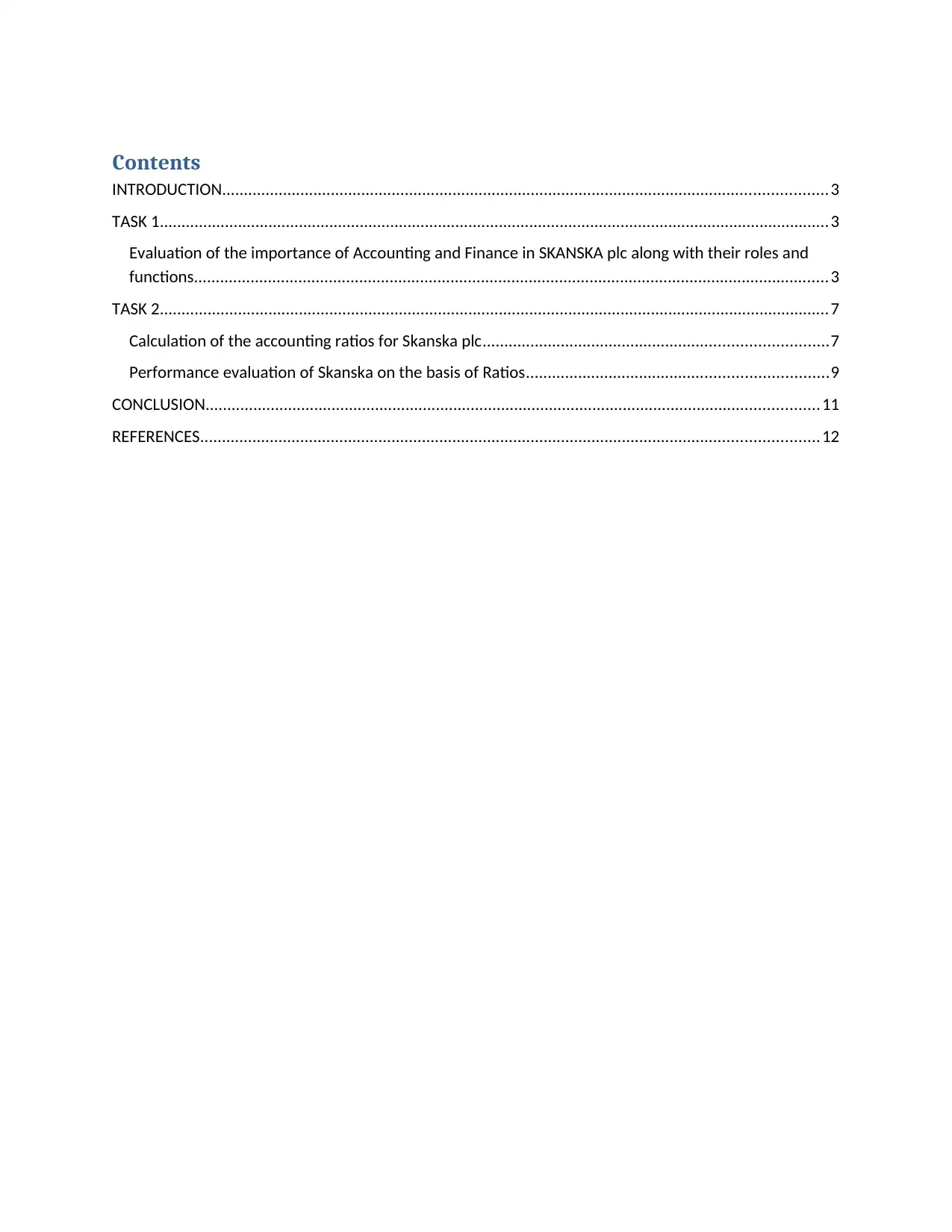
Contents
INTRODUCTION...........................................................................................................................................3
TASK 1..........................................................................................................................................................3
Evaluation of the importance of Accounting and Finance in SKANSKA plc along with their roles and
functions..................................................................................................................................................3
TASK 2..........................................................................................................................................................7
Calculation of the accounting ratios for Skanska plc...............................................................................7
Performance evaluation of Skanska on the basis of Ratios.....................................................................9
CONCLUSION.............................................................................................................................................11
REFERENCES..............................................................................................................................................12
INTRODUCTION...........................................................................................................................................3
TASK 1..........................................................................................................................................................3
Evaluation of the importance of Accounting and Finance in SKANSKA plc along with their roles and
functions..................................................................................................................................................3
TASK 2..........................................................................................................................................................7
Calculation of the accounting ratios for Skanska plc...............................................................................7
Performance evaluation of Skanska on the basis of Ratios.....................................................................9
CONCLUSION.............................................................................................................................................11
REFERENCES..............................................................................................................................................12
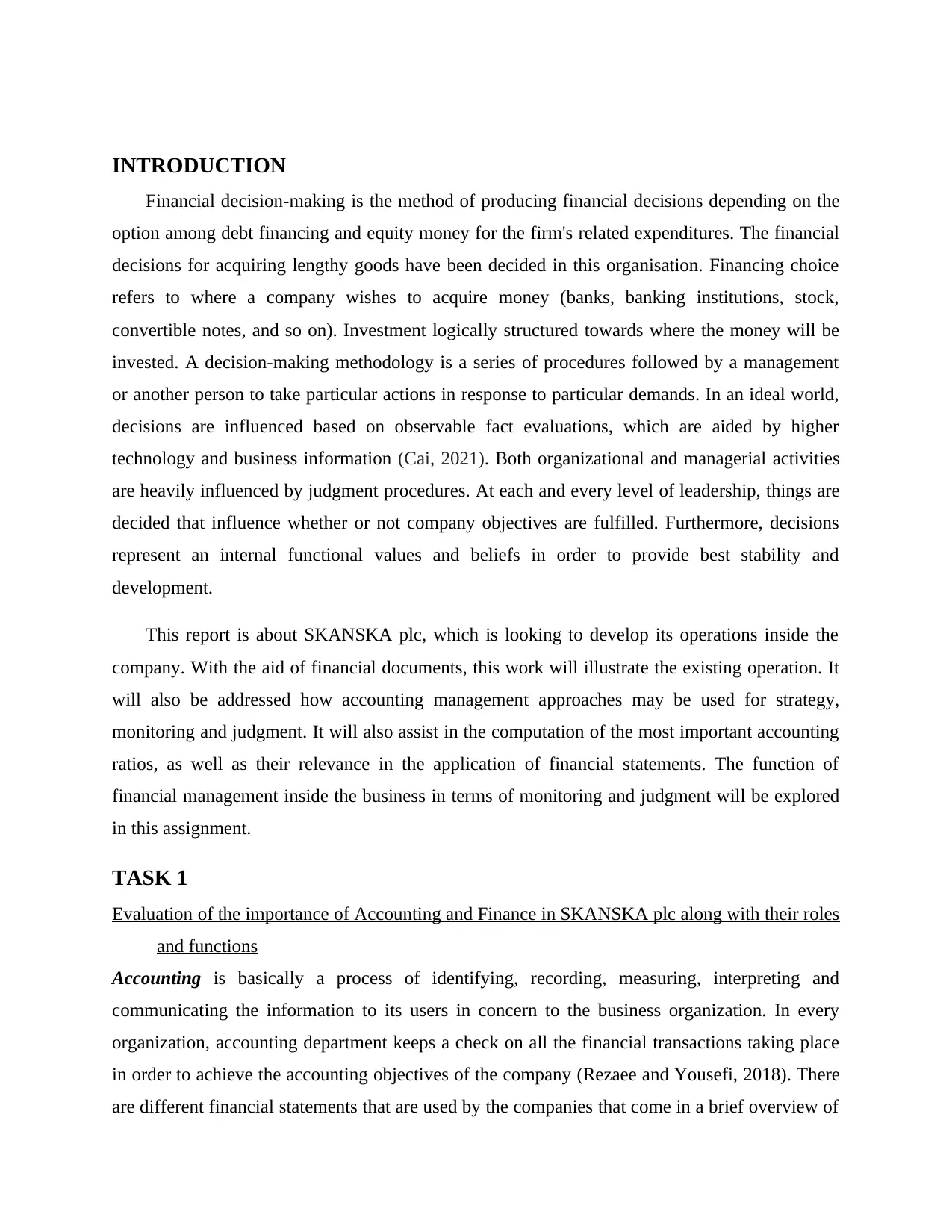
INTRODUCTION
Financial decision-making is the method of producing financial decisions depending on the
option among debt financing and equity money for the firm's related expenditures. The financial
decisions for acquiring lengthy goods have been decided in this organisation. Financing choice
refers to where a company wishes to acquire money (banks, banking institutions, stock,
convertible notes, and so on). Investment logically structured towards where the money will be
invested. A decision-making methodology is a series of procedures followed by a management
or another person to take particular actions in response to particular demands. In an ideal world,
decisions are influenced based on observable fact evaluations, which are aided by higher
technology and business information (Cai, 2021). Both organizational and managerial activities
are heavily influenced by judgment procedures. At each and every level of leadership, things are
decided that influence whether or not company objectives are fulfilled. Furthermore, decisions
represent an internal functional values and beliefs in order to provide best stability and
development.
This report is about SKANSKA plc, which is looking to develop its operations inside the
company. With the aid of financial documents, this work will illustrate the existing operation. It
will also be addressed how accounting management approaches may be used for strategy,
monitoring and judgment. It will also assist in the computation of the most important accounting
ratios, as well as their relevance in the application of financial statements. The function of
financial management inside the business in terms of monitoring and judgment will be explored
in this assignment.
TASK 1
Evaluation of the importance of Accounting and Finance in SKANSKA plc along with their roles
and functions
Accounting is basically a process of identifying, recording, measuring, interpreting and
communicating the information to its users in concern to the business organization. In every
organization, accounting department keeps a check on all the financial transactions taking place
in order to achieve the accounting objectives of the company (Rezaee and Yousefi, 2018). There
are different financial statements that are used by the companies that come in a brief overview of
Financial decision-making is the method of producing financial decisions depending on the
option among debt financing and equity money for the firm's related expenditures. The financial
decisions for acquiring lengthy goods have been decided in this organisation. Financing choice
refers to where a company wishes to acquire money (banks, banking institutions, stock,
convertible notes, and so on). Investment logically structured towards where the money will be
invested. A decision-making methodology is a series of procedures followed by a management
or another person to take particular actions in response to particular demands. In an ideal world,
decisions are influenced based on observable fact evaluations, which are aided by higher
technology and business information (Cai, 2021). Both organizational and managerial activities
are heavily influenced by judgment procedures. At each and every level of leadership, things are
decided that influence whether or not company objectives are fulfilled. Furthermore, decisions
represent an internal functional values and beliefs in order to provide best stability and
development.
This report is about SKANSKA plc, which is looking to develop its operations inside the
company. With the aid of financial documents, this work will illustrate the existing operation. It
will also be addressed how accounting management approaches may be used for strategy,
monitoring and judgment. It will also assist in the computation of the most important accounting
ratios, as well as their relevance in the application of financial statements. The function of
financial management inside the business in terms of monitoring and judgment will be explored
in this assignment.
TASK 1
Evaluation of the importance of Accounting and Finance in SKANSKA plc along with their roles
and functions
Accounting is basically a process of identifying, recording, measuring, interpreting and
communicating the information to its users in concern to the business organization. In every
organization, accounting department keeps a check on all the financial transactions taking place
in order to achieve the accounting objectives of the company (Rezaee and Yousefi, 2018). There
are different financial statements that are used by the companies that come in a brief overview of
Secure Best Marks with AI Grader
Need help grading? Try our AI Grader for instant feedback on your assignments.
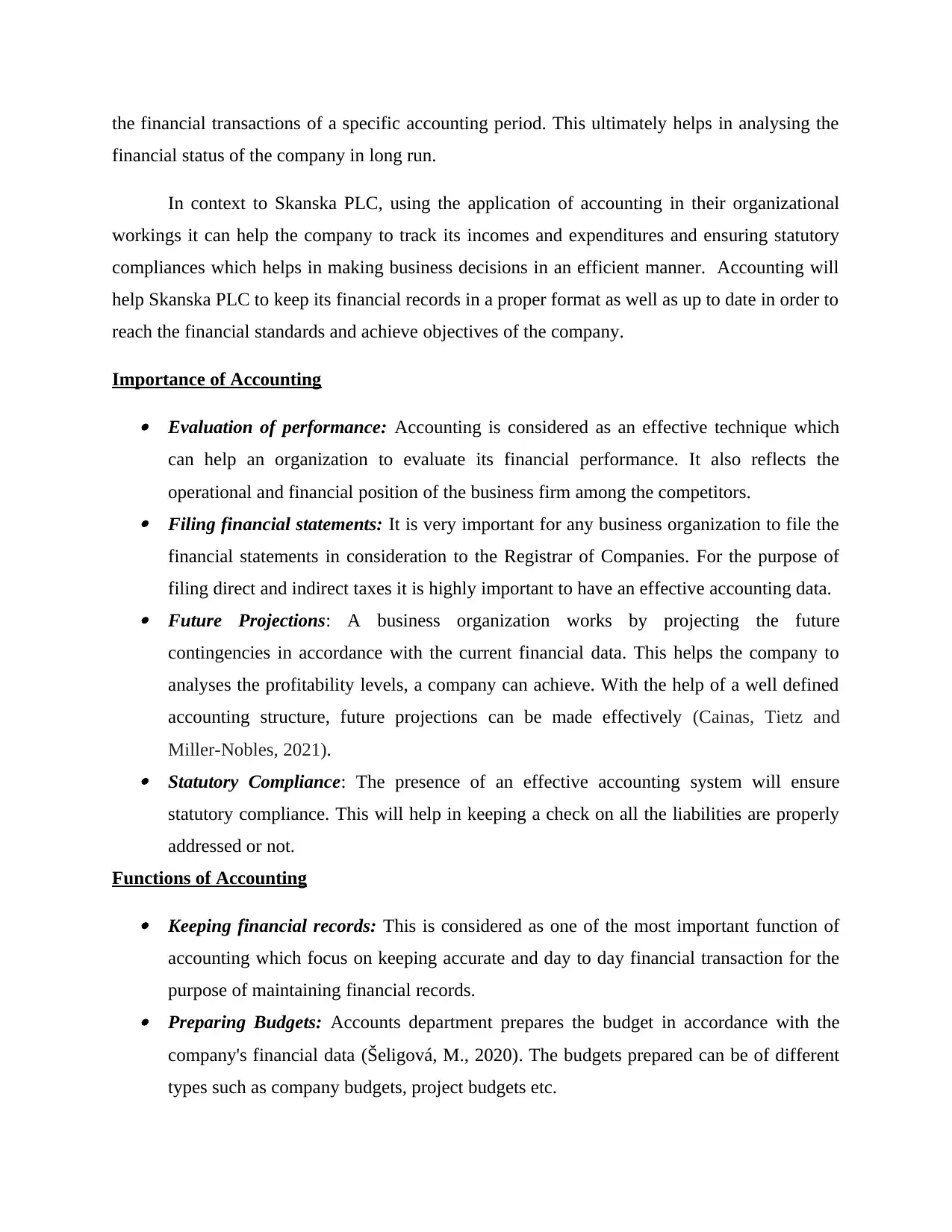
the financial transactions of a specific accounting period. This ultimately helps in analysing the
financial status of the company in long run.
In context to Skanska PLC, using the application of accounting in their organizational
workings it can help the company to track its incomes and expenditures and ensuring statutory
compliances which helps in making business decisions in an efficient manner. Accounting will
help Skanska PLC to keep its financial records in a proper format as well as up to date in order to
reach the financial standards and achieve objectives of the company.
Importance of Accounting
Evaluation of performance: Accounting is considered as an effective technique which
can help an organization to evaluate its financial performance. It also reflects the
operational and financial position of the business firm among the competitors. Filing financial statements: It is very important for any business organization to file the
financial statements in consideration to the Registrar of Companies. For the purpose of
filing direct and indirect taxes it is highly important to have an effective accounting data. Future Projections: A business organization works by projecting the future
contingencies in accordance with the current financial data. This helps the company to
analyses the profitability levels, a company can achieve. With the help of a well defined
accounting structure, future projections can be made effectively (Cainas, Tietz and
Miller-Nobles, 2021). Statutory Compliance: The presence of an effective accounting system will ensure
statutory compliance. This will help in keeping a check on all the liabilities are properly
addressed or not.
Functions of Accounting
Keeping financial records: This is considered as one of the most important function of
accounting which focus on keeping accurate and day to day financial transaction for the
purpose of maintaining financial records. Preparing Budgets: Accounts department prepares the budget in accordance with the
company's financial data (Šeligová, M., 2020). The budgets prepared can be of different
types such as company budgets, project budgets etc.
financial status of the company in long run.
In context to Skanska PLC, using the application of accounting in their organizational
workings it can help the company to track its incomes and expenditures and ensuring statutory
compliances which helps in making business decisions in an efficient manner. Accounting will
help Skanska PLC to keep its financial records in a proper format as well as up to date in order to
reach the financial standards and achieve objectives of the company.
Importance of Accounting
Evaluation of performance: Accounting is considered as an effective technique which
can help an organization to evaluate its financial performance. It also reflects the
operational and financial position of the business firm among the competitors. Filing financial statements: It is very important for any business organization to file the
financial statements in consideration to the Registrar of Companies. For the purpose of
filing direct and indirect taxes it is highly important to have an effective accounting data. Future Projections: A business organization works by projecting the future
contingencies in accordance with the current financial data. This helps the company to
analyses the profitability levels, a company can achieve. With the help of a well defined
accounting structure, future projections can be made effectively (Cainas, Tietz and
Miller-Nobles, 2021). Statutory Compliance: The presence of an effective accounting system will ensure
statutory compliance. This will help in keeping a check on all the liabilities are properly
addressed or not.
Functions of Accounting
Keeping financial records: This is considered as one of the most important function of
accounting which focus on keeping accurate and day to day financial transaction for the
purpose of maintaining financial records. Preparing Budgets: Accounts department prepares the budget in accordance with the
company's financial data (Šeligová, M., 2020). The budgets prepared can be of different
types such as company budgets, project budgets etc.
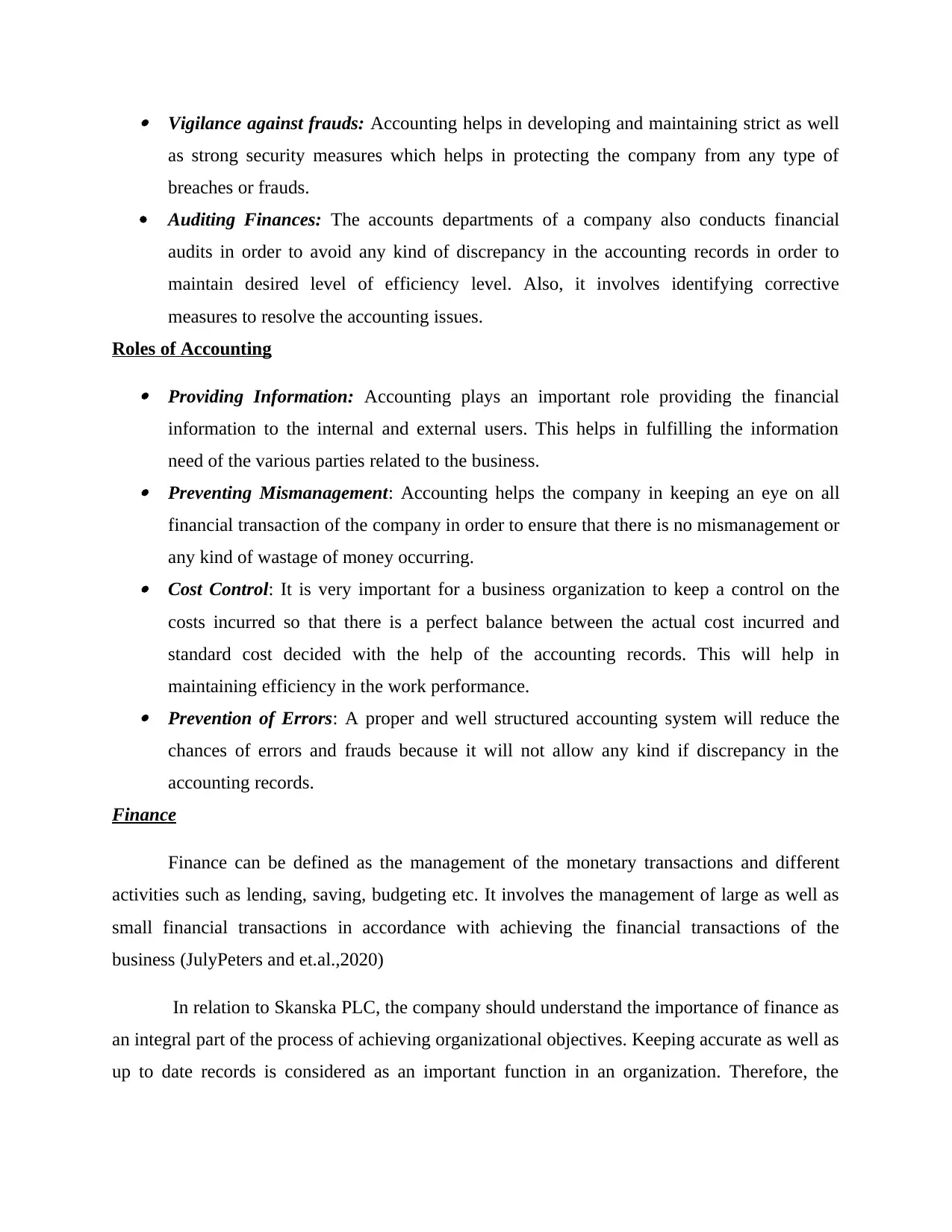
Vigilance against frauds: Accounting helps in developing and maintaining strict as well
as strong security measures which helps in protecting the company from any type of
breaches or frauds.
Auditing Finances: The accounts departments of a company also conducts financial
audits in order to avoid any kind of discrepancy in the accounting records in order to
maintain desired level of efficiency level. Also, it involves identifying corrective
measures to resolve the accounting issues.
Roles of Accounting
Providing Information: Accounting plays an important role providing the financial
information to the internal and external users. This helps in fulfilling the information
need of the various parties related to the business. Preventing Mismanagement: Accounting helps the company in keeping an eye on all
financial transaction of the company in order to ensure that there is no mismanagement or
any kind of wastage of money occurring. Cost Control: It is very important for a business organization to keep a control on the
costs incurred so that there is a perfect balance between the actual cost incurred and
standard cost decided with the help of the accounting records. This will help in
maintaining efficiency in the work performance. Prevention of Errors: A proper and well structured accounting system will reduce the
chances of errors and frauds because it will not allow any kind if discrepancy in the
accounting records.
Finance
Finance can be defined as the management of the monetary transactions and different
activities such as lending, saving, budgeting etc. It involves the management of large as well as
small financial transactions in accordance with achieving the financial transactions of the
business (JulyPeters and et.al.,2020)
In relation to Skanska PLC, the company should understand the importance of finance as
an integral part of the process of achieving organizational objectives. Keeping accurate as well as
up to date records is considered as an important function in an organization. Therefore, the
as strong security measures which helps in protecting the company from any type of
breaches or frauds.
Auditing Finances: The accounts departments of a company also conducts financial
audits in order to avoid any kind of discrepancy in the accounting records in order to
maintain desired level of efficiency level. Also, it involves identifying corrective
measures to resolve the accounting issues.
Roles of Accounting
Providing Information: Accounting plays an important role providing the financial
information to the internal and external users. This helps in fulfilling the information
need of the various parties related to the business. Preventing Mismanagement: Accounting helps the company in keeping an eye on all
financial transaction of the company in order to ensure that there is no mismanagement or
any kind of wastage of money occurring. Cost Control: It is very important for a business organization to keep a control on the
costs incurred so that there is a perfect balance between the actual cost incurred and
standard cost decided with the help of the accounting records. This will help in
maintaining efficiency in the work performance. Prevention of Errors: A proper and well structured accounting system will reduce the
chances of errors and frauds because it will not allow any kind if discrepancy in the
accounting records.
Finance
Finance can be defined as the management of the monetary transactions and different
activities such as lending, saving, budgeting etc. It involves the management of large as well as
small financial transactions in accordance with achieving the financial transactions of the
business (JulyPeters and et.al.,2020)
In relation to Skanska PLC, the company should understand the importance of finance as
an integral part of the process of achieving organizational objectives. Keeping accurate as well as
up to date records is considered as an important function in an organization. Therefore, the
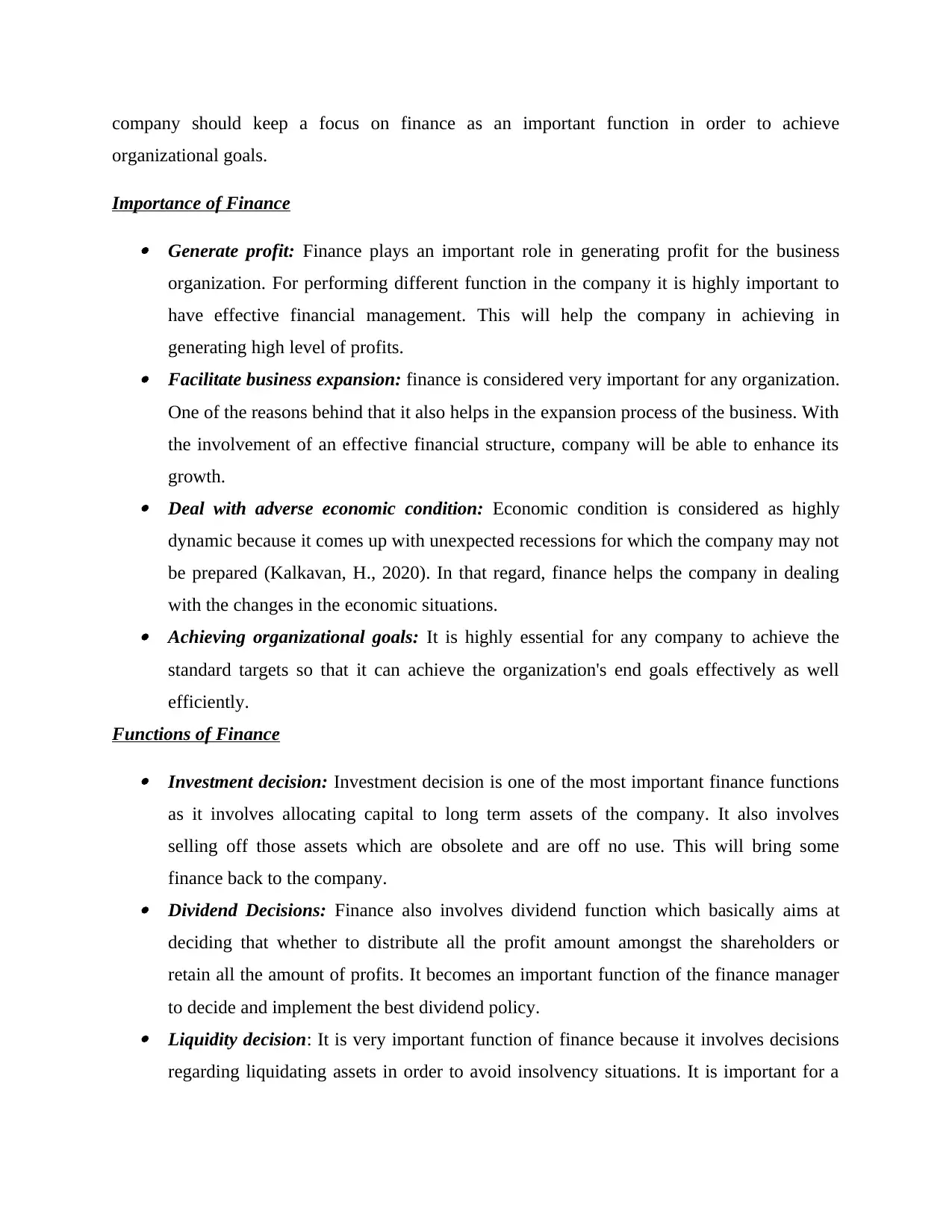
company should keep a focus on finance as an important function in order to achieve
organizational goals.
Importance of Finance
Generate profit: Finance plays an important role in generating profit for the business
organization. For performing different function in the company it is highly important to
have effective financial management. This will help the company in achieving in
generating high level of profits. Facilitate business expansion: finance is considered very important for any organization.
One of the reasons behind that it also helps in the expansion process of the business. With
the involvement of an effective financial structure, company will be able to enhance its
growth. Deal with adverse economic condition: Economic condition is considered as highly
dynamic because it comes up with unexpected recessions for which the company may not
be prepared (Kalkavan, H., 2020). In that regard, finance helps the company in dealing
with the changes in the economic situations. Achieving organizational goals: It is highly essential for any company to achieve the
standard targets so that it can achieve the organization's end goals effectively as well
efficiently.
Functions of Finance
Investment decision: Investment decision is one of the most important finance functions
as it involves allocating capital to long term assets of the company. It also involves
selling off those assets which are obsolete and are off no use. This will bring some
finance back to the company. Dividend Decisions: Finance also involves dividend function which basically aims at
deciding that whether to distribute all the profit amount amongst the shareholders or
retain all the amount of profits. It becomes an important function of the finance manager
to decide and implement the best dividend policy. Liquidity decision: It is very important function of finance because it involves decisions
regarding liquidating assets in order to avoid insolvency situations. It is important for a
organizational goals.
Importance of Finance
Generate profit: Finance plays an important role in generating profit for the business
organization. For performing different function in the company it is highly important to
have effective financial management. This will help the company in achieving in
generating high level of profits. Facilitate business expansion: finance is considered very important for any organization.
One of the reasons behind that it also helps in the expansion process of the business. With
the involvement of an effective financial structure, company will be able to enhance its
growth. Deal with adverse economic condition: Economic condition is considered as highly
dynamic because it comes up with unexpected recessions for which the company may not
be prepared (Kalkavan, H., 2020). In that regard, finance helps the company in dealing
with the changes in the economic situations. Achieving organizational goals: It is highly essential for any company to achieve the
standard targets so that it can achieve the organization's end goals effectively as well
efficiently.
Functions of Finance
Investment decision: Investment decision is one of the most important finance functions
as it involves allocating capital to long term assets of the company. It also involves
selling off those assets which are obsolete and are off no use. This will bring some
finance back to the company. Dividend Decisions: Finance also involves dividend function which basically aims at
deciding that whether to distribute all the profit amount amongst the shareholders or
retain all the amount of profits. It becomes an important function of the finance manager
to decide and implement the best dividend policy. Liquidity decision: It is very important function of finance because it involves decisions
regarding liquidating assets in order to avoid insolvency situations. It is important for a
Paraphrase This Document
Need a fresh take? Get an instant paraphrase of this document with our AI Paraphraser
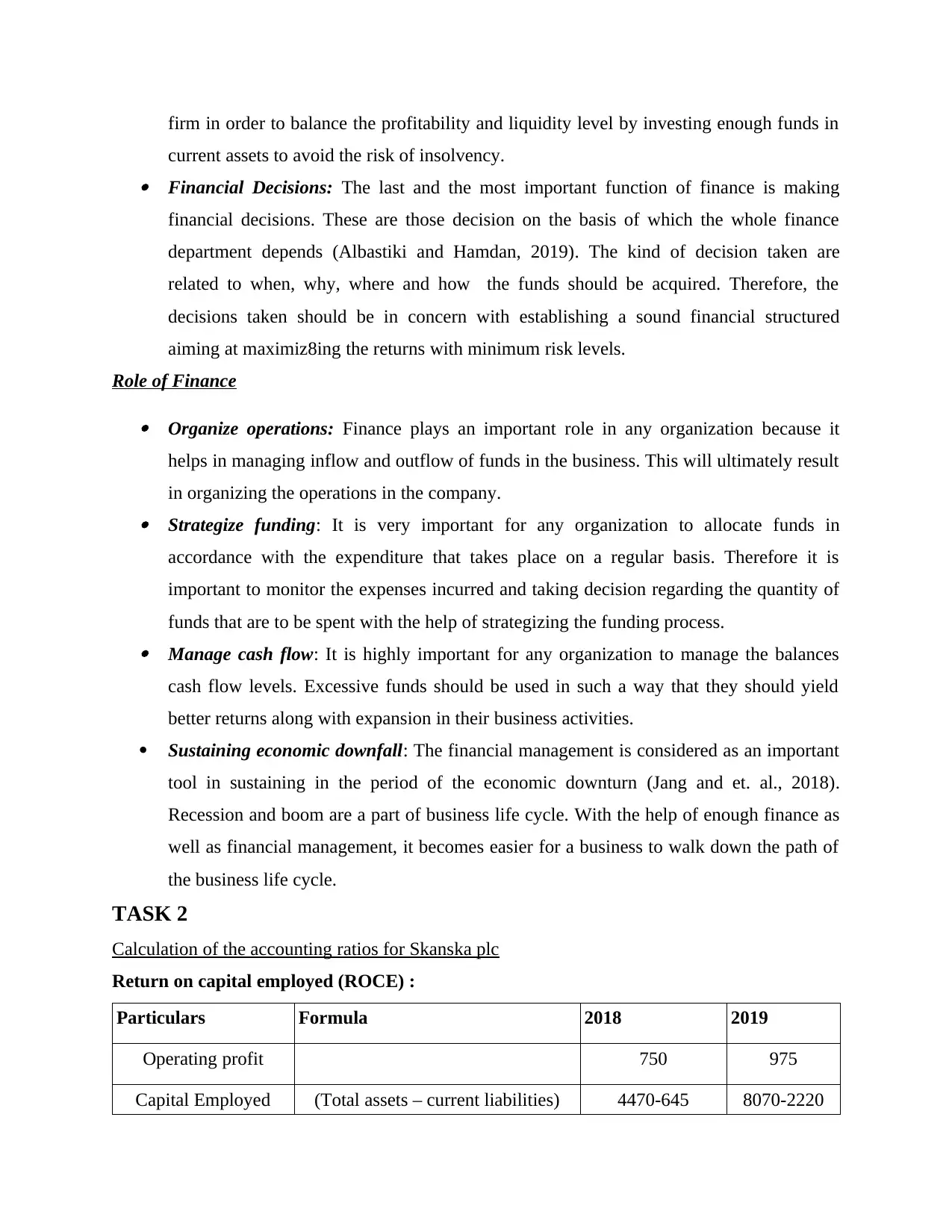
firm in order to balance the profitability and liquidity level by investing enough funds in
current assets to avoid the risk of insolvency. Financial Decisions: The last and the most important function of finance is making
financial decisions. These are those decision on the basis of which the whole finance
department depends (Albastiki and Hamdan, 2019). The kind of decision taken are
related to when, why, where and how the funds should be acquired. Therefore, the
decisions taken should be in concern with establishing a sound financial structured
aiming at maximiz8ing the returns with minimum risk levels.
Role of Finance
Organize operations: Finance plays an important role in any organization because it
helps in managing inflow and outflow of funds in the business. This will ultimately result
in organizing the operations in the company. Strategize funding: It is very important for any organization to allocate funds in
accordance with the expenditure that takes place on a regular basis. Therefore it is
important to monitor the expenses incurred and taking decision regarding the quantity of
funds that are to be spent with the help of strategizing the funding process. Manage cash flow: It is highly important for any organization to manage the balances
cash flow levels. Excessive funds should be used in such a way that they should yield
better returns along with expansion in their business activities.
Sustaining economic downfall: The financial management is considered as an important
tool in sustaining in the period of the economic downturn (Jang and et. al., 2018).
Recession and boom are a part of business life cycle. With the help of enough finance as
well as financial management, it becomes easier for a business to walk down the path of
the business life cycle.
TASK 2
Calculation of the accounting ratios for Skanska plc
Return on capital employed (ROCE) :
Particulars Formula 2018 2019
Operating profit 750 975
Capital Employed (Total assets – current liabilities) 4470-645 8070-2220
current assets to avoid the risk of insolvency. Financial Decisions: The last and the most important function of finance is making
financial decisions. These are those decision on the basis of which the whole finance
department depends (Albastiki and Hamdan, 2019). The kind of decision taken are
related to when, why, where and how the funds should be acquired. Therefore, the
decisions taken should be in concern with establishing a sound financial structured
aiming at maximiz8ing the returns with minimum risk levels.
Role of Finance
Organize operations: Finance plays an important role in any organization because it
helps in managing inflow and outflow of funds in the business. This will ultimately result
in organizing the operations in the company. Strategize funding: It is very important for any organization to allocate funds in
accordance with the expenditure that takes place on a regular basis. Therefore it is
important to monitor the expenses incurred and taking decision regarding the quantity of
funds that are to be spent with the help of strategizing the funding process. Manage cash flow: It is highly important for any organization to manage the balances
cash flow levels. Excessive funds should be used in such a way that they should yield
better returns along with expansion in their business activities.
Sustaining economic downfall: The financial management is considered as an important
tool in sustaining in the period of the economic downturn (Jang and et. al., 2018).
Recession and boom are a part of business life cycle. With the help of enough finance as
well as financial management, it becomes easier for a business to walk down the path of
the business life cycle.
TASK 2
Calculation of the accounting ratios for Skanska plc
Return on capital employed (ROCE) :
Particulars Formula 2018 2019
Operating profit 750 975
Capital Employed (Total assets – current liabilities) 4470-645 8070-2220
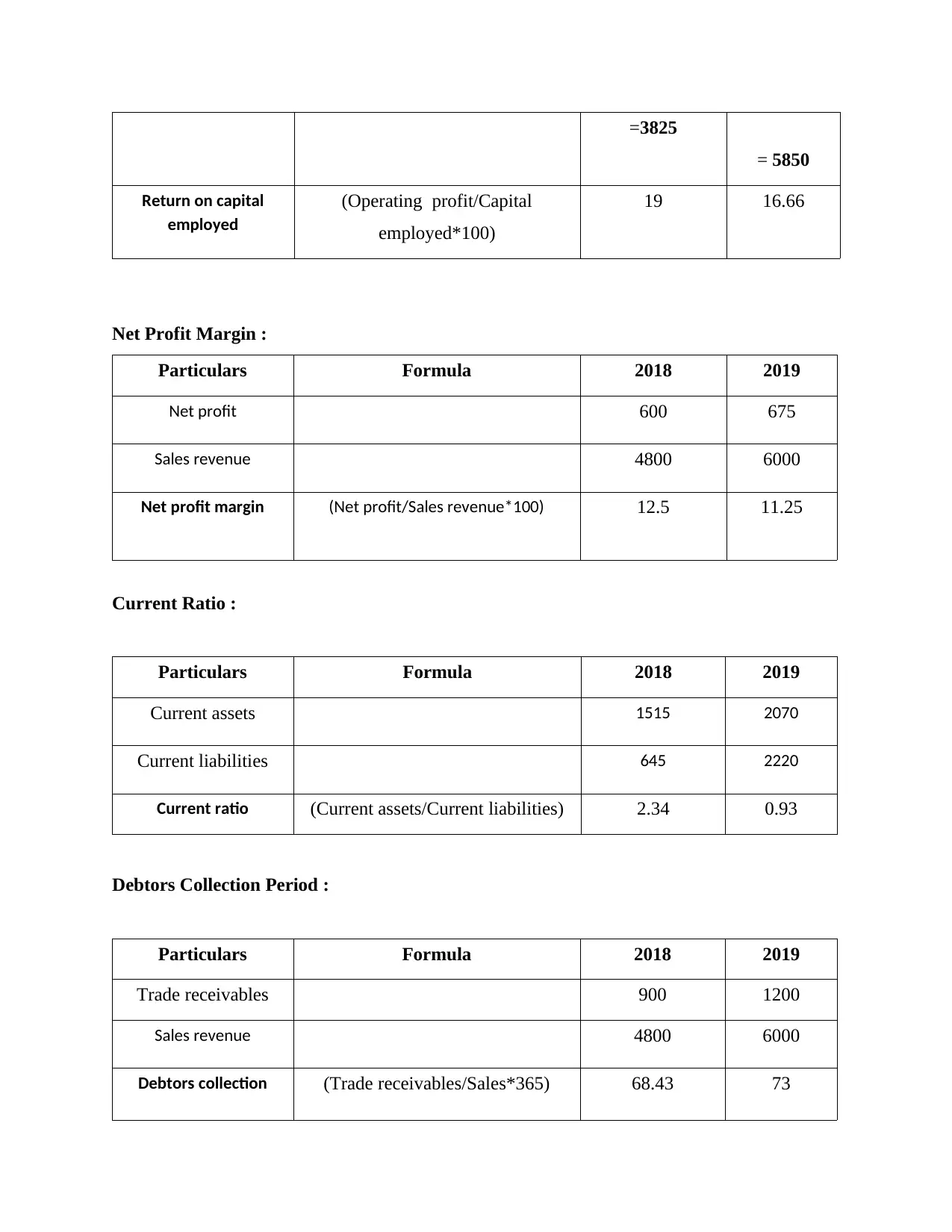
=3825
= 5850
Return on capital
employed
(Operating profit/Capital
employed*100)
19 16.66
Net Profit Margin :
Particulars Formula 2018 2019
Net profit 600 675
Sales revenue 4800 6000
Net profit margin (Net profit/Sales revenue*100) 12.5 11.25
Current Ratio :
Particulars Formula 2018 2019
Current assets 1515 2070
Current liabilities 645 2220
Current ratio (Current assets/Current liabilities) 2.34 0.93
Debtors Collection Period :
Particulars Formula 2018 2019
Trade receivables 900 1200
Sales revenue 4800 6000
Debtors collection (Trade receivables/Sales*365) 68.43 73
= 5850
Return on capital
employed
(Operating profit/Capital
employed*100)
19 16.66
Net Profit Margin :
Particulars Formula 2018 2019
Net profit 600 675
Sales revenue 4800 6000
Net profit margin (Net profit/Sales revenue*100) 12.5 11.25
Current Ratio :
Particulars Formula 2018 2019
Current assets 1515 2070
Current liabilities 645 2220
Current ratio (Current assets/Current liabilities) 2.34 0.93
Debtors Collection Period :
Particulars Formula 2018 2019
Trade receivables 900 1200
Sales revenue 4800 6000
Debtors collection (Trade receivables/Sales*365) 68.43 73
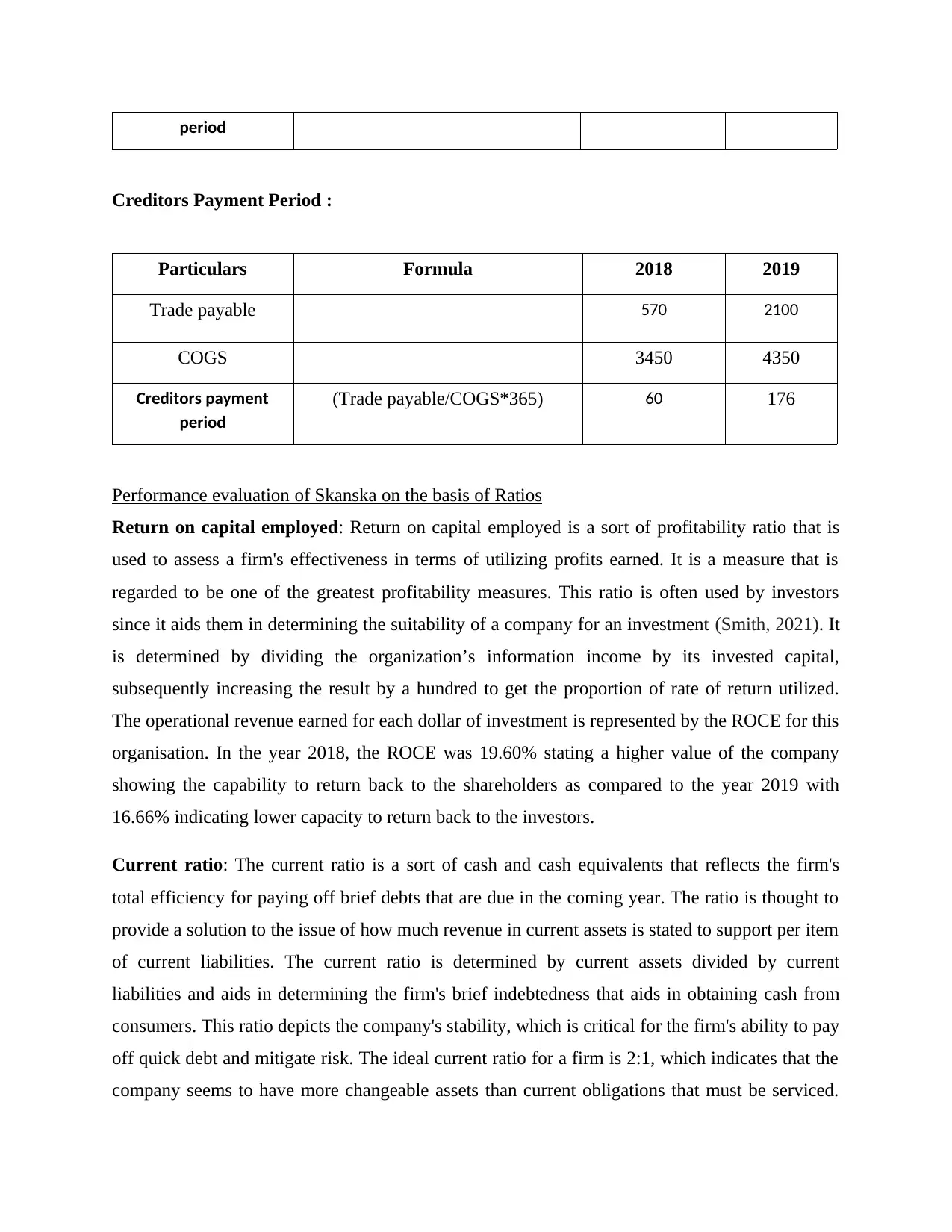
period
Creditors Payment Period :
Particulars Formula 2018 2019
Trade payable 570 2100
COGS 3450 4350
Creditors payment
period
(Trade payable/COGS*365) 60 176
Performance evaluation of Skanska on the basis of Ratios
Return on capital employed: Return on capital employed is a sort of profitability ratio that is
used to assess a firm's effectiveness in terms of utilizing profits earned. It is a measure that is
regarded to be one of the greatest profitability measures. This ratio is often used by investors
since it aids them in determining the suitability of a company for an investment (Smith, 2021). It
is determined by dividing the organization’s information income by its invested capital,
subsequently increasing the result by a hundred to get the proportion of rate of return utilized.
The operational revenue earned for each dollar of investment is represented by the ROCE for this
organisation. In the year 2018, the ROCE was 19.60% stating a higher value of the company
showing the capability to return back to the shareholders as compared to the year 2019 with
16.66% indicating lower capacity to return back to the investors.
Current ratio: The current ratio is a sort of cash and cash equivalents that reflects the firm's
total efficiency for paying off brief debts that are due in the coming year. The ratio is thought to
provide a solution to the issue of how much revenue in current assets is stated to support per item
of current liabilities. The current ratio is determined by current assets divided by current
liabilities and aids in determining the firm's brief indebtedness that aids in obtaining cash from
consumers. This ratio depicts the company's stability, which is critical for the firm's ability to pay
off quick debt and mitigate risk. The ideal current ratio for a firm is 2:1, which indicates that the
company seems to have more changeable assets than current obligations that must be serviced.
Creditors Payment Period :
Particulars Formula 2018 2019
Trade payable 570 2100
COGS 3450 4350
Creditors payment
period
(Trade payable/COGS*365) 60 176
Performance evaluation of Skanska on the basis of Ratios
Return on capital employed: Return on capital employed is a sort of profitability ratio that is
used to assess a firm's effectiveness in terms of utilizing profits earned. It is a measure that is
regarded to be one of the greatest profitability measures. This ratio is often used by investors
since it aids them in determining the suitability of a company for an investment (Smith, 2021). It
is determined by dividing the organization’s information income by its invested capital,
subsequently increasing the result by a hundred to get the proportion of rate of return utilized.
The operational revenue earned for each dollar of investment is represented by the ROCE for this
organisation. In the year 2018, the ROCE was 19.60% stating a higher value of the company
showing the capability to return back to the shareholders as compared to the year 2019 with
16.66% indicating lower capacity to return back to the investors.
Current ratio: The current ratio is a sort of cash and cash equivalents that reflects the firm's
total efficiency for paying off brief debts that are due in the coming year. The ratio is thought to
provide a solution to the issue of how much revenue in current assets is stated to support per item
of current liabilities. The current ratio is determined by current assets divided by current
liabilities and aids in determining the firm's brief indebtedness that aids in obtaining cash from
consumers. This ratio depicts the company's stability, which is critical for the firm's ability to pay
off quick debt and mitigate risk. The ideal current ratio for a firm is 2:1, which indicates that the
company seems to have more changeable assets than current obligations that must be serviced.
Secure Best Marks with AI Grader
Need help grading? Try our AI Grader for instant feedback on your assignments.
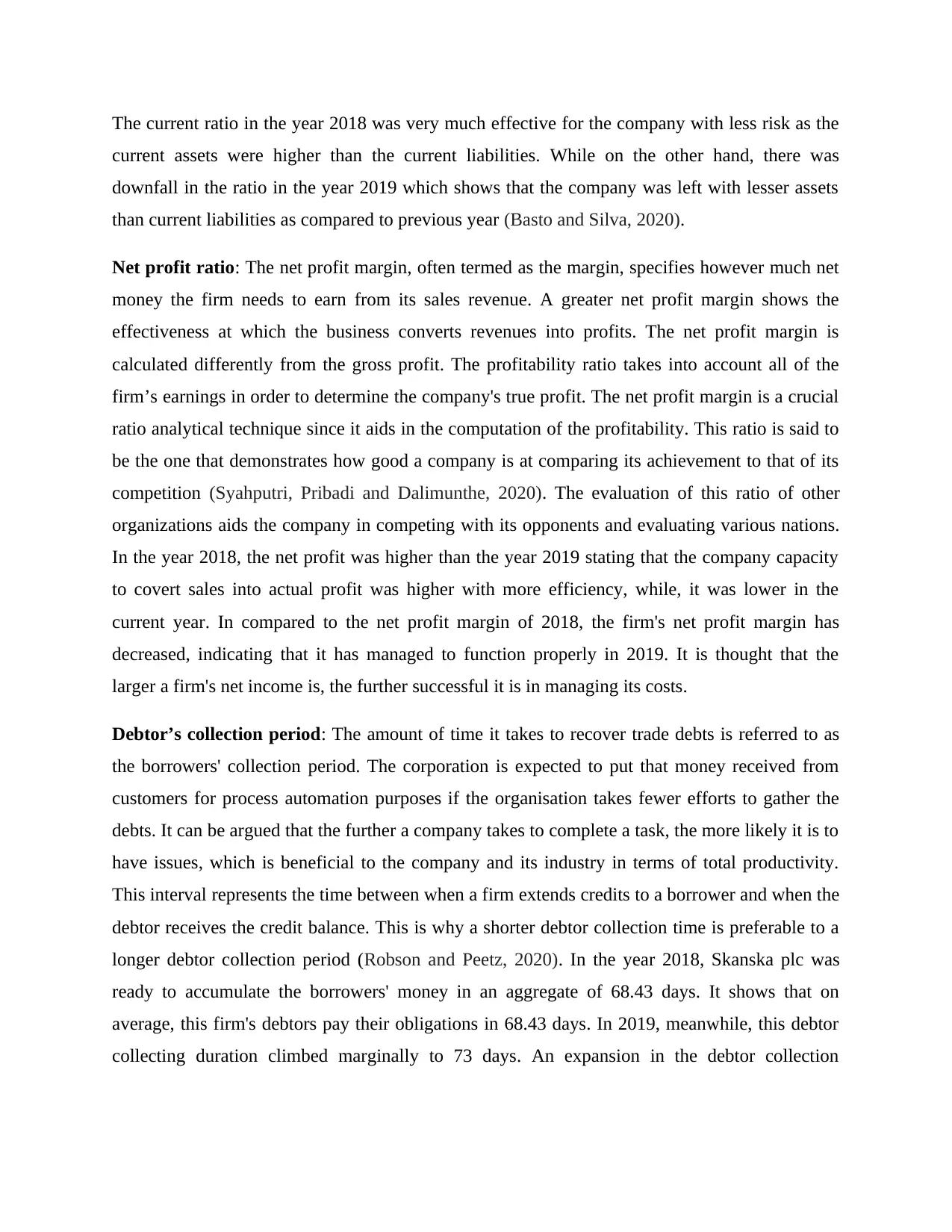
The current ratio in the year 2018 was very much effective for the company with less risk as the
current assets were higher than the current liabilities. While on the other hand, there was
downfall in the ratio in the year 2019 which shows that the company was left with lesser assets
than current liabilities as compared to previous year (Basto and Silva, 2020).
Net profit ratio: The net profit margin, often termed as the margin, specifies however much net
money the firm needs to earn from its sales revenue. A greater net profit margin shows the
effectiveness at which the business converts revenues into profits. The net profit margin is
calculated differently from the gross profit. The profitability ratio takes into account all of the
firm’s earnings in order to determine the company's true profit. The net profit margin is a crucial
ratio analytical technique since it aids in the computation of the profitability. This ratio is said to
be the one that demonstrates how good a company is at comparing its achievement to that of its
competition (Syahputri, Pribadi and Dalimunthe, 2020). The evaluation of this ratio of other
organizations aids the company in competing with its opponents and evaluating various nations.
In the year 2018, the net profit was higher than the year 2019 stating that the company capacity
to covert sales into actual profit was higher with more efficiency, while, it was lower in the
current year. In compared to the net profit margin of 2018, the firm's net profit margin has
decreased, indicating that it has managed to function properly in 2019. It is thought that the
larger a firm's net income is, the further successful it is in managing its costs.
Debtor’s collection period: The amount of time it takes to recover trade debts is referred to as
the borrowers' collection period. The corporation is expected to put that money received from
customers for process automation purposes if the organisation takes fewer efforts to gather the
debts. It can be argued that the further a company takes to complete a task, the more likely it is to
have issues, which is beneficial to the company and its industry in terms of total productivity.
This interval represents the time between when a firm extends credits to a borrower and when the
debtor receives the credit balance. This is why a shorter debtor collection time is preferable to a
longer debtor collection period (Robson and Peetz, 2020). In the year 2018, Skanska plc was
ready to accumulate the borrowers' money in an aggregate of 68.43 days. It shows that on
average, this firm's debtors pay their obligations in 68.43 days. In 2019, meanwhile, this debtor
collecting duration climbed marginally to 73 days. An expansion in the debtor collection
current assets were higher than the current liabilities. While on the other hand, there was
downfall in the ratio in the year 2019 which shows that the company was left with lesser assets
than current liabilities as compared to previous year (Basto and Silva, 2020).
Net profit ratio: The net profit margin, often termed as the margin, specifies however much net
money the firm needs to earn from its sales revenue. A greater net profit margin shows the
effectiveness at which the business converts revenues into profits. The net profit margin is
calculated differently from the gross profit. The profitability ratio takes into account all of the
firm’s earnings in order to determine the company's true profit. The net profit margin is a crucial
ratio analytical technique since it aids in the computation of the profitability. This ratio is said to
be the one that demonstrates how good a company is at comparing its achievement to that of its
competition (Syahputri, Pribadi and Dalimunthe, 2020). The evaluation of this ratio of other
organizations aids the company in competing with its opponents and evaluating various nations.
In the year 2018, the net profit was higher than the year 2019 stating that the company capacity
to covert sales into actual profit was higher with more efficiency, while, it was lower in the
current year. In compared to the net profit margin of 2018, the firm's net profit margin has
decreased, indicating that it has managed to function properly in 2019. It is thought that the
larger a firm's net income is, the further successful it is in managing its costs.
Debtor’s collection period: The amount of time it takes to recover trade debts is referred to as
the borrowers' collection period. The corporation is expected to put that money received from
customers for process automation purposes if the organisation takes fewer efforts to gather the
debts. It can be argued that the further a company takes to complete a task, the more likely it is to
have issues, which is beneficial to the company and its industry in terms of total productivity.
This interval represents the time between when a firm extends credits to a borrower and when the
debtor receives the credit balance. This is why a shorter debtor collection time is preferable to a
longer debtor collection period (Robson and Peetz, 2020). In the year 2018, Skanska plc was
ready to accumulate the borrowers' money in an aggregate of 68.43 days. It shows that on
average, this firm's debtors pay their obligations in 68.43 days. In 2019, meanwhile, this debtor
collecting duration climbed marginally to 73 days. An expansion in the debtor collection
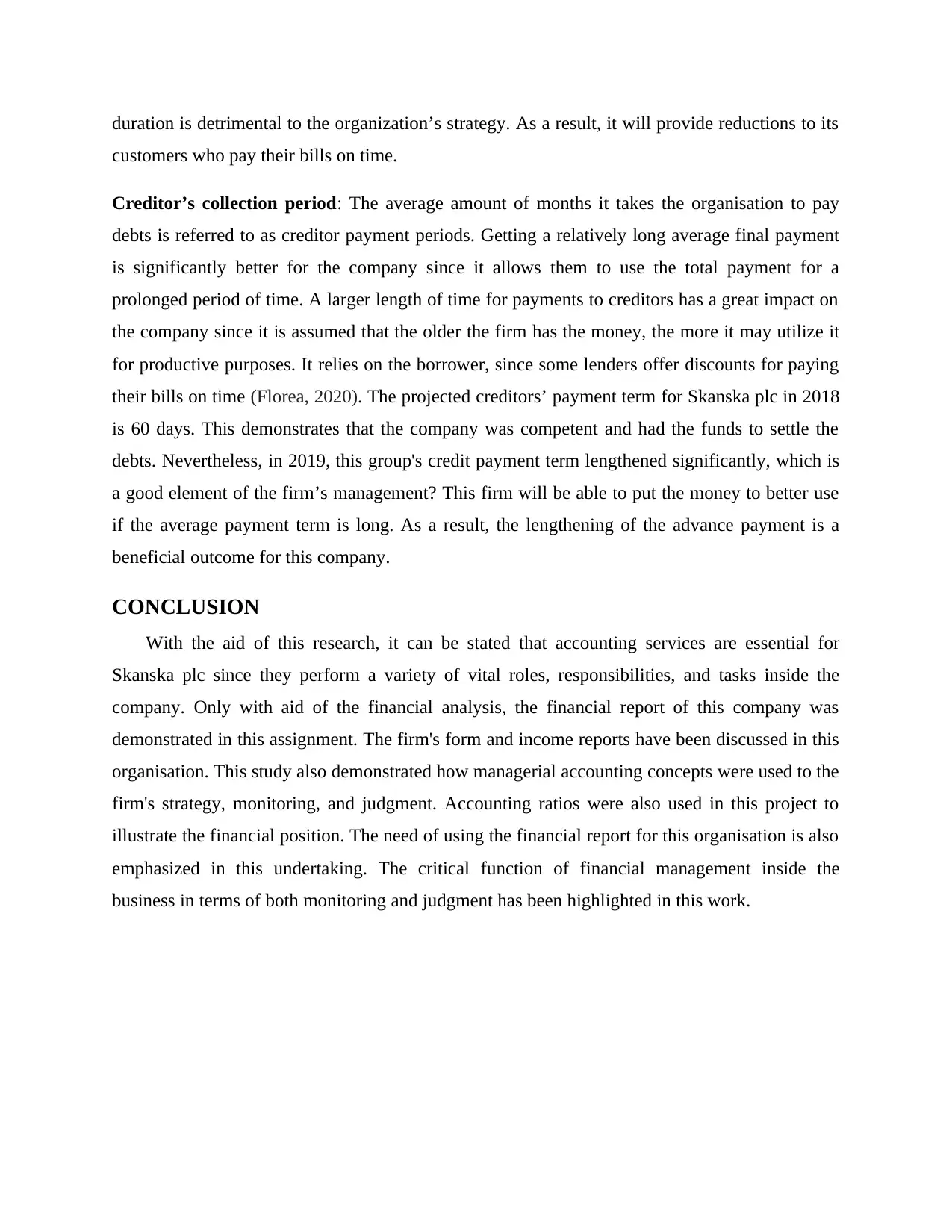
duration is detrimental to the organization’s strategy. As a result, it will provide reductions to its
customers who pay their bills on time.
Creditor’s collection period: The average amount of months it takes the organisation to pay
debts is referred to as creditor payment periods. Getting a relatively long average final payment
is significantly better for the company since it allows them to use the total payment for a
prolonged period of time. A larger length of time for payments to creditors has a great impact on
the company since it is assumed that the older the firm has the money, the more it may utilize it
for productive purposes. It relies on the borrower, since some lenders offer discounts for paying
their bills on time (Florea, 2020). The projected creditors’ payment term for Skanska plc in 2018
is 60 days. This demonstrates that the company was competent and had the funds to settle the
debts. Nevertheless, in 2019, this group's credit payment term lengthened significantly, which is
a good element of the firm’s management? This firm will be able to put the money to better use
if the average payment term is long. As a result, the lengthening of the advance payment is a
beneficial outcome for this company.
CONCLUSION
With the aid of this research, it can be stated that accounting services are essential for
Skanska plc since they perform a variety of vital roles, responsibilities, and tasks inside the
company. Only with aid of the financial analysis, the financial report of this company was
demonstrated in this assignment. The firm's form and income reports have been discussed in this
organisation. This study also demonstrated how managerial accounting concepts were used to the
firm's strategy, monitoring, and judgment. Accounting ratios were also used in this project to
illustrate the financial position. The need of using the financial report for this organisation is also
emphasized in this undertaking. The critical function of financial management inside the
business in terms of both monitoring and judgment has been highlighted in this work.
customers who pay their bills on time.
Creditor’s collection period: The average amount of months it takes the organisation to pay
debts is referred to as creditor payment periods. Getting a relatively long average final payment
is significantly better for the company since it allows them to use the total payment for a
prolonged period of time. A larger length of time for payments to creditors has a great impact on
the company since it is assumed that the older the firm has the money, the more it may utilize it
for productive purposes. It relies on the borrower, since some lenders offer discounts for paying
their bills on time (Florea, 2020). The projected creditors’ payment term for Skanska plc in 2018
is 60 days. This demonstrates that the company was competent and had the funds to settle the
debts. Nevertheless, in 2019, this group's credit payment term lengthened significantly, which is
a good element of the firm’s management? This firm will be able to put the money to better use
if the average payment term is long. As a result, the lengthening of the advance payment is a
beneficial outcome for this company.
CONCLUSION
With the aid of this research, it can be stated that accounting services are essential for
Skanska plc since they perform a variety of vital roles, responsibilities, and tasks inside the
company. Only with aid of the financial analysis, the financial report of this company was
demonstrated in this assignment. The firm's form and income reports have been discussed in this
organisation. This study also demonstrated how managerial accounting concepts were used to the
firm's strategy, monitoring, and judgment. Accounting ratios were also used in this project to
illustrate the financial position. The need of using the financial report for this organisation is also
emphasized in this undertaking. The critical function of financial management inside the
business in terms of both monitoring and judgment has been highlighted in this work.
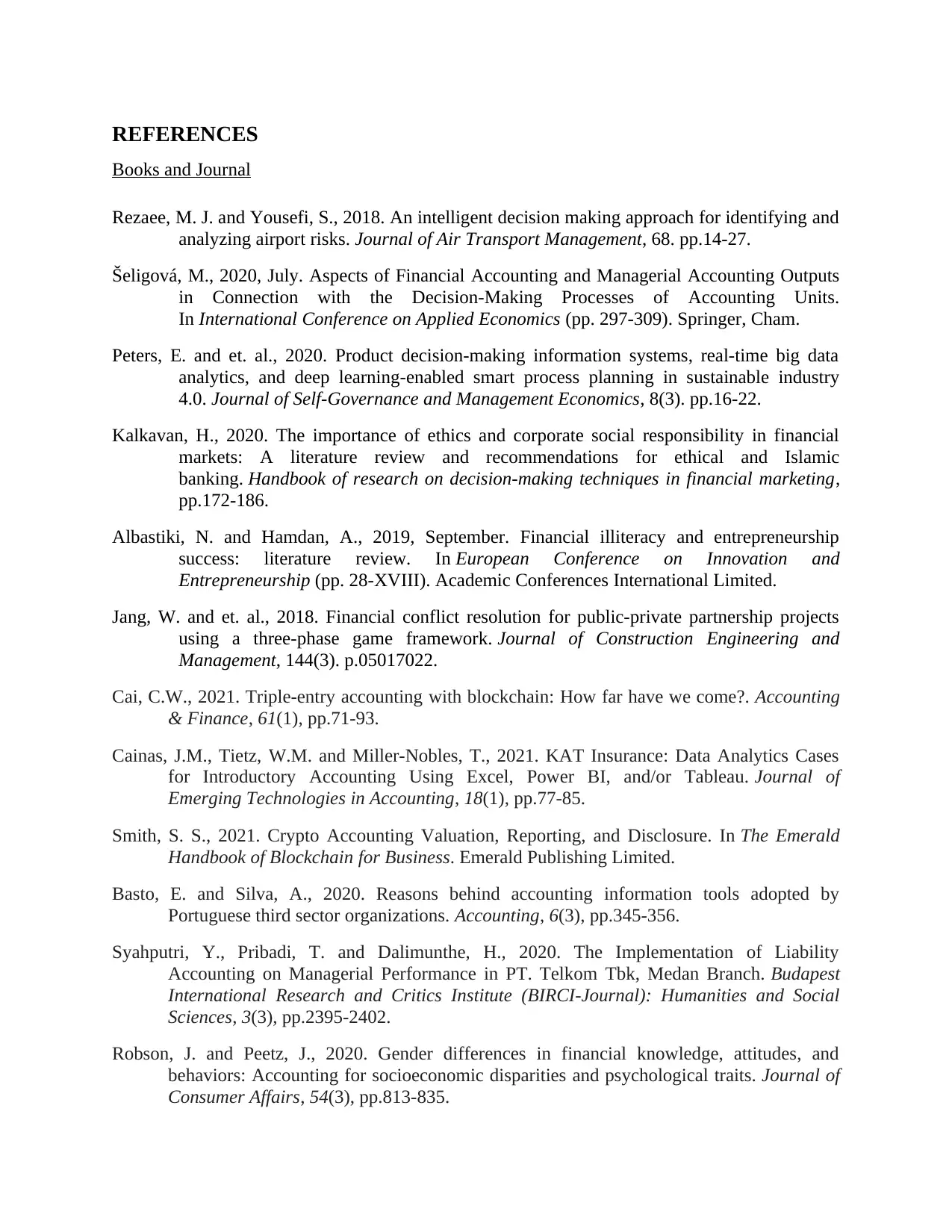
REFERENCES
Books and Journal
Rezaee, M. J. and Yousefi, S., 2018. An intelligent decision making approach for identifying and
analyzing airport risks. Journal of Air Transport Management, 68. pp.14-27.
Šeligová, M., 2020, July. Aspects of Financial Accounting and Managerial Accounting Outputs
in Connection with the Decision-Making Processes of Accounting Units.
In International Conference on Applied Economics (pp. 297-309). Springer, Cham.
Peters, E. and et. al., 2020. Product decision-making information systems, real-time big data
analytics, and deep learning-enabled smart process planning in sustainable industry
4.0. Journal of Self-Governance and Management Economics, 8(3). pp.16-22.
Kalkavan, H., 2020. The importance of ethics and corporate social responsibility in financial
markets: A literature review and recommendations for ethical and Islamic
banking. Handbook of research on decision-making techniques in financial marketing,
pp.172-186.
Albastiki, N. and Hamdan, A., 2019, September. Financial illiteracy and entrepreneurship
success: literature review. In European Conference on Innovation and
Entrepreneurship (pp. 28-XVIII). Academic Conferences International Limited.
Jang, W. and et. al., 2018. Financial conflict resolution for public-private partnership projects
using a three-phase game framework. Journal of Construction Engineering and
Management, 144(3). p.05017022.
Cai, C.W., 2021. Triple‐entry accounting with blockchain: How far have we come?. Accounting
& Finance, 61(1), pp.71-93.
Cainas, J.M., Tietz, W.M. and Miller-Nobles, T., 2021. KAT Insurance: Data Analytics Cases
for Introductory Accounting Using Excel, Power BI, and/or Tableau. Journal of
Emerging Technologies in Accounting, 18(1), pp.77-85.
Smith, S. S., 2021. Crypto Accounting Valuation, Reporting, and Disclosure. In The Emerald
Handbook of Blockchain for Business. Emerald Publishing Limited.
Basto, E. and Silva, A., 2020. Reasons behind accounting information tools adopted by
Portuguese third sector organizations. Accounting, 6(3), pp.345-356.
Syahputri, Y., Pribadi, T. and Dalimunthe, H., 2020. The Implementation of Liability
Accounting on Managerial Performance in PT. Telkom Tbk, Medan Branch. Budapest
International Research and Critics Institute (BIRCI-Journal): Humanities and Social
Sciences, 3(3), pp.2395-2402.
Robson, J. and Peetz, J., 2020. Gender differences in financial knowledge, attitudes, and
behaviors: Accounting for socioeconomic disparities and psychological traits. Journal of
Consumer Affairs, 54(3), pp.813-835.
Books and Journal
Rezaee, M. J. and Yousefi, S., 2018. An intelligent decision making approach for identifying and
analyzing airport risks. Journal of Air Transport Management, 68. pp.14-27.
Šeligová, M., 2020, July. Aspects of Financial Accounting and Managerial Accounting Outputs
in Connection with the Decision-Making Processes of Accounting Units.
In International Conference on Applied Economics (pp. 297-309). Springer, Cham.
Peters, E. and et. al., 2020. Product decision-making information systems, real-time big data
analytics, and deep learning-enabled smart process planning in sustainable industry
4.0. Journal of Self-Governance and Management Economics, 8(3). pp.16-22.
Kalkavan, H., 2020. The importance of ethics and corporate social responsibility in financial
markets: A literature review and recommendations for ethical and Islamic
banking. Handbook of research on decision-making techniques in financial marketing,
pp.172-186.
Albastiki, N. and Hamdan, A., 2019, September. Financial illiteracy and entrepreneurship
success: literature review. In European Conference on Innovation and
Entrepreneurship (pp. 28-XVIII). Academic Conferences International Limited.
Jang, W. and et. al., 2018. Financial conflict resolution for public-private partnership projects
using a three-phase game framework. Journal of Construction Engineering and
Management, 144(3). p.05017022.
Cai, C.W., 2021. Triple‐entry accounting with blockchain: How far have we come?. Accounting
& Finance, 61(1), pp.71-93.
Cainas, J.M., Tietz, W.M. and Miller-Nobles, T., 2021. KAT Insurance: Data Analytics Cases
for Introductory Accounting Using Excel, Power BI, and/or Tableau. Journal of
Emerging Technologies in Accounting, 18(1), pp.77-85.
Smith, S. S., 2021. Crypto Accounting Valuation, Reporting, and Disclosure. In The Emerald
Handbook of Blockchain for Business. Emerald Publishing Limited.
Basto, E. and Silva, A., 2020. Reasons behind accounting information tools adopted by
Portuguese third sector organizations. Accounting, 6(3), pp.345-356.
Syahputri, Y., Pribadi, T. and Dalimunthe, H., 2020. The Implementation of Liability
Accounting on Managerial Performance in PT. Telkom Tbk, Medan Branch. Budapest
International Research and Critics Institute (BIRCI-Journal): Humanities and Social
Sciences, 3(3), pp.2395-2402.
Robson, J. and Peetz, J., 2020. Gender differences in financial knowledge, attitudes, and
behaviors: Accounting for socioeconomic disparities and psychological traits. Journal of
Consumer Affairs, 54(3), pp.813-835.
Paraphrase This Document
Need a fresh take? Get an instant paraphrase of this document with our AI Paraphraser

Florea, C. F., 2020. Fiscal cost management: means of using financial and accounting
information. Academic Journal of Economic Studies, 6(2), pp.112-121.
information. Academic Journal of Economic Studies, 6(2), pp.112-121.
1 out of 14
Related Documents
Your All-in-One AI-Powered Toolkit for Academic Success.
+13062052269
info@desklib.com
Available 24*7 on WhatsApp / Email
![[object Object]](/_next/static/media/star-bottom.7253800d.svg)
Unlock your academic potential
© 2024 | Zucol Services PVT LTD | All rights reserved.



